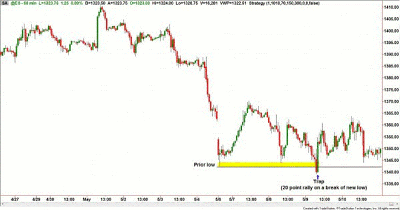Conventional wisdom about buying new highs or lows can get E-mini traders trapped in false moves, explains Gabe Velasquez, instructor for Online Trading Academy, citing two textbook examples.
One axiom that has stuck with me throughout my career is the one used when traders are on a losing streak and they refer to engaging the market as “Picking daisies in a minefield.” This saying references the notion that when the market looks very good, this is usually when it blows up.
It’s not limited to going long, either; shorts also find huge reversals to the upside just when the market looks as though it’s ready to fall off into the abyss. We see this time and again, as the markets are full of traps to which the unsuspecting novice trader is prone to falling victim.
One of these traps is the idea that when prices trade above or below prominent price points, the particular investment vehicle is bullish or bearish. These price points can be a variety of technical levels, some of which are commonly referred to as support or resistance. Others can be a prior day’s high or low (pivots). The overnight peaks and troughs (known as the Globex) are seen in this fashion as well.
In the two charts below, you can see what those traps look like:
In the last E-mini class I taught two weeks ago, we spotted a possible trap in the ES (E-mini S&P) and some students bought the “new low” in the S&P mini at 1340 (shown in the top chart). This worked very nicely, as ES rallied 20 points.
In the bottom chart, we can see that a few days later, the Nasdaq mini futures contract had a similar trap—a new high—and as we can see, it proceeded to fall 50 points in quick succession.
For traders wishing not to fall into this trap, it is important to know what causes this to happen. Going back to the class I was teaching two weeks ago, the first session in the morning was devoted to trading and analysis. On the particular day when the trap occurred, the S&P was down sharply, and I made the comment that I would love to see yesterday’s low get taken out, as that would provide a good buying opportunity. I got a few puzzled looks from students after making that statement, as they didn’t understand why we would buy when the market was making lower lows.
The first point I made to them is that many traders are “conditioned” by all the books on conventional technical analysis to buy new highs or lows. As I mentioned earlier, this tends to make them bullish or bearish depending on where prices trade. There are many instances where the new highs actually act as pullback areas in a trade.
See also: 3 Early Signs of an Intraday Reversal
In other words, a higher high in the context of an uptrend quite frequently acts as the high point before a retracement, thus stopping out those that chase the trend.
The next and most important point is that often times right above or below these new highs and lows are supply and demand levels that act as repellants to those new buyers or sellers. This is exactly what happened in the two examples shown above.
If you look closely inside those larger-time-frame candles, you will discover those pockets of buy and sell orders just waiting to get filled.
Since many of you have been reading these articles for a while, I suspect you probably don’t buy new highs or sell new lows in your own trading. For the rest of you, making sure you don’t fall prey to this particular trap means learning how to identify quality supply and demand levels, as well as learning that conventional thinking is a trap in itself.
See related: It All Starts with Supply and Demand
By Gabe Velasquez, instructor, Online Trading Academy























